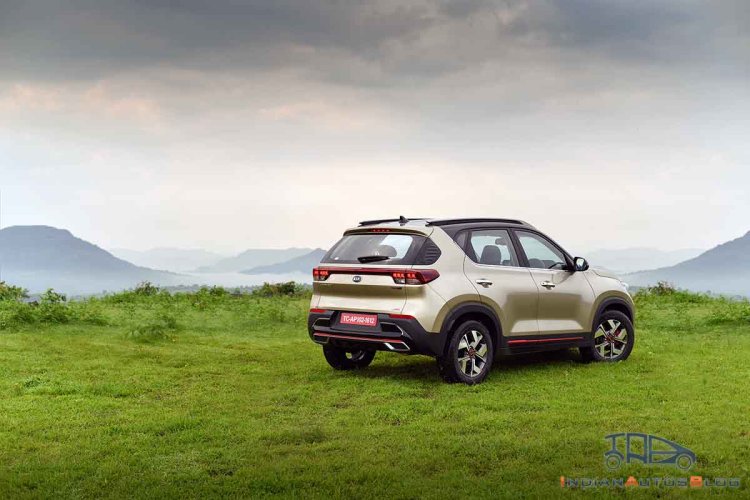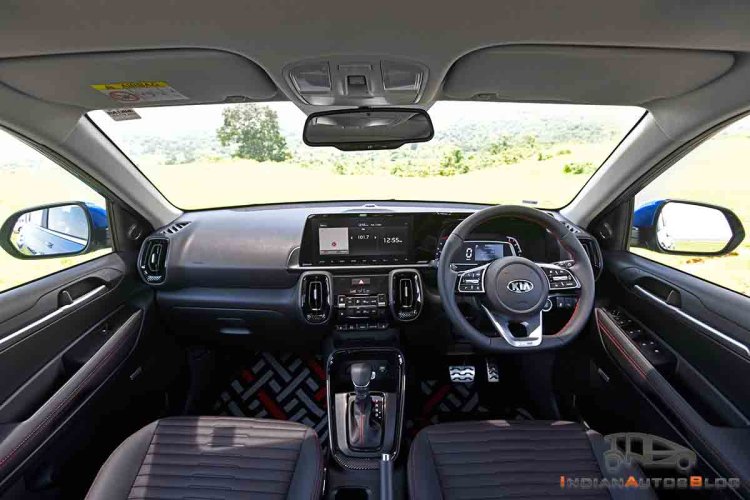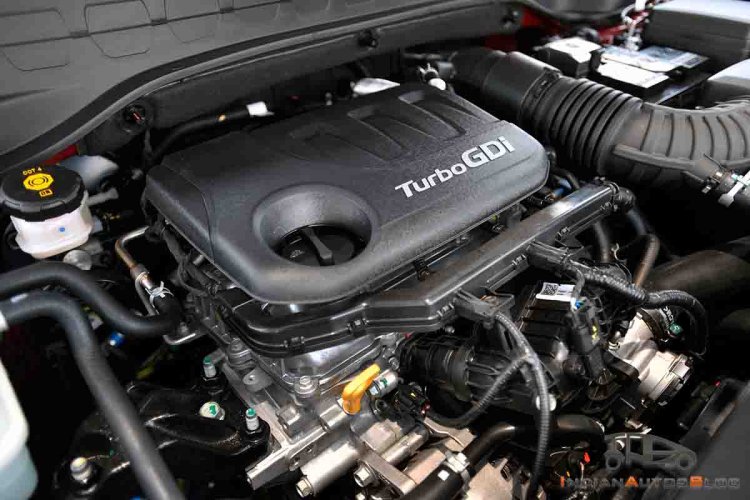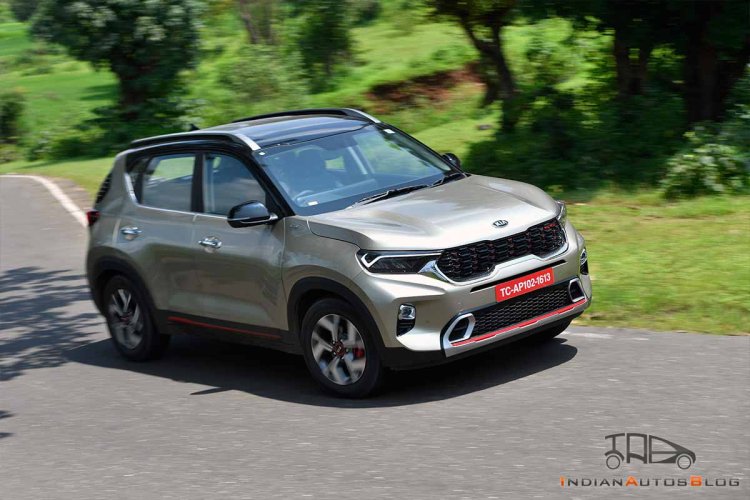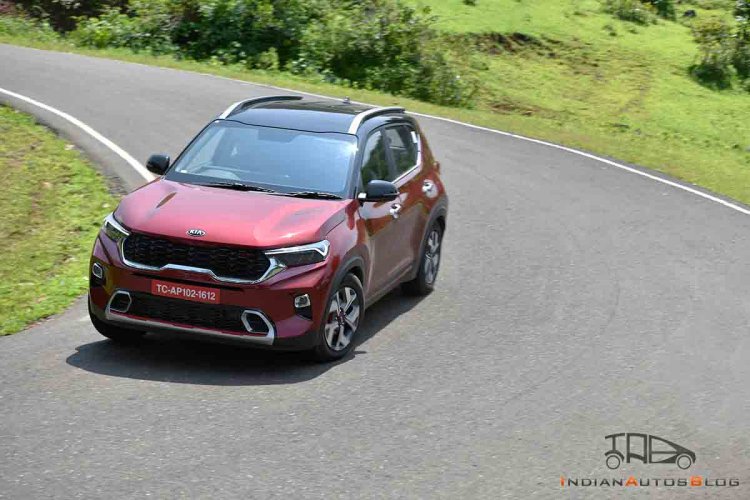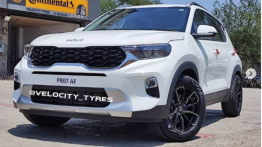Prologue
After a gazillion speculations, Kia Motors finally made its foray into the Indian market in August 2019, with the Seltos becoming its maiden product for our highly value-conscious-but-fast-emerging local car market. Little over a year later, the carmaker is ready to try its luck at cracking the entry-level SUV segment with the Kia Sonet. Previewed by a show-stopping concept at this year's Auto Expo, the production version retains the cheeky look. They say never judge a book by its cover, even though that's what covers are made for, and that's exactly why we, at IndianAutosBlog, decided to get up close and personal with the Kia Sonet. The lines that follow are an account of our rendezvous with the most highly anticipated car of present times.
Looks a Million Bucks
Market-ready iterations are mostly a far cry from their stunning concept models but a quick look at the Kia Sonet is enough to dismiss all such pre-conceived notions. The production-spec Sonet oozes of a rather Transformers-esque boldness that gives the new sub-compact SUV the ability to instantly grab eyeballs. In fact, the Sonet actually comes as a breath of fresh air in a segment that is dominated by the plain-jane Maruti Vitara Brezza. That said, ultra-modern design themes tend to polarize opinions across the age bar and we're yet to see if the Sonet can appeal across generations of car buyers.
I, for once, am all for that deliciously modern front facade. The highlights here include the signature 'Tiger Nose' grille, albeit, in an evolved format, a well-sculpted bumper with faux air-intakes, and very sleek LED headlights with 'Heartbeat' DRLs. The side profile further reinforces the visual connection with the Seltos, especially due to the dual-tone colour schemes and a steeply rising beltline. An interesting design detail here is the usage of a gloss-black plastic panel on the C-pillar, which helps create an impression of the Sonet having a wrap-around rear windscreen, a la Mercedes M-Class. A close inspection, however, reveals the somewhat tacky feel of these plastic inserts. Some other outstanding bits of the profile include dual-tone machine-cut mag rims and a rather large-ish DLO.
While the front-end and profile impress with largely clean surfaces and crisp creases, things get too busy at the rear-end. It's not like we're being dismissive of the posterior but it definitely lacks the suave appeal of the nose. That said, the 'connected' tail lamps work well to accentuate the width of the sub-compact SUV, while the faux exhaust end-cans add a touch of sportiness. The sculpted tailgate works well to lend the Sonet a contemporary look. What's also important to mention here is that akin to the Seltos, the Sonet will be available in two flavours - Tech Line and GT Line. The latter is reserved for the top-spec variant and brings in several red accents, inside and out, in a bid to impress buyers wishing to add some spice to this mini-me Seltos.
Great Things Come in Small Packages
Well, those who have checked out this new sub-compact SUV at authorized dealerships have already let the cat out of the bag - the Kia Sonet isn't the most spacious car in its segment, no, not by any stretch of the imagination. Given the Hyundai Venue-roots, this comes as hardly surprising. Before we take you through the (many) highlights of the equipment list, let's be clear here that interior space is somewhat of an Achilles' Heels of the Sonet. Under most circumstances, the rear bench seat is good for two healthy adults and anything beyond this is, well, a bit too much. Okay, four adults and a small kid are the most you would want to try, unless, of course, you're not too fond of a couple of family members. Surprisingly, Kia has managed to squeeze out the segment-largest boot space of 392-litres, a good 42-litres more than what the Hyundai Venue offers. Even the loading lip isn't too high and boot opening is fairly wide to help you easily load your luggage.
While the cramped rear might be a deal-breaker for some, there’s no denying the totally upmarket cabin ambience that the Kia Sonet offers. The quality of materials and the fit-and-finish is simply top-notch and nothing like anything ever seen before in this segment. The dashboard plastics are of great quality and all the knobs and buttons have a very positive feel to them. The steering wheel comes from the Seltos and features the same high-quality leather-wrap. The seats are well-bolstered and offer great lumbar support. Personally, I’ve never been a fan of digital instrument clusters but I’m sure many would like this ‘modern’ touch. The major highlight of the dashboard is a 10.25-inch touchscreen infotainment unit that’s as big as the one on the Seltos. It supports Android Auto, Apple CarPlay, Multi-screen layouts, et al. However, it’s important to mention here that this isn’t the same unit as the one on the elder sibling and doesn’t offer the same quality of graphics. The UI, however, is quite intuitive and all this together makes for the best infotainment unit in the segment.
You even get segment-topping equipment list, with goodies like an electric sunroof, 7-speaker Bose audio system, air purifier with virus protection, perfume dispenser, UVO connected car technology, ventilated front seats, front and rear parking sensors, six airbags, ABS and ESC, Hill Start Assist Control and emergency braking warning available on the top-spec trim.
Mighty Mite
The parts sharing between the Kia Sonet and Hyundai Venue ensures that the baby-Seltos offers all the powertrain options available on the donor model. Additionally, the Sonet is even offered with the same diesel-auto option as its elder sibling, which gives it a clear advantage over the Venue. So, in all, the Hyundai Venue-based Maruti Vitara Brezza-rival is available in 5 engine-transmission combinations - 83PS-112 Nm 1.2-litre naturally-aspirated petrol manual, 120PS-172Nm 1.0-litre turbo-petrol iMT, 120PS-172Nm 1.0-litre turbo-petrol DCT, 100PS-240Nm 1.5-litre FGT Diesel-manual, and 115PS-250Nm 1.5-litre VGT Diesel-automatic. Of these, we could sample the 1.0 Turbo-petrol with the brand-spanking-new clutchless manual transmission from Hyundai Motor Group along with the Diesel-auto model with the Seltos-sourced powertrain.
The engine performance of the turbo-petrol variant hardly holds any surprises as it's pretty close to what we recently sampled on the Hyundai Venue Turbo iMT. An iMT actually makes brilliant sense for new drivers or, for that matter, anyone with gruellingly long commutes with stop-go traffic. The clutchless manual transmission is a brilliant amalgam of the convenience offered by a two-pedal setup and the control provided by a stick shift. What this also meant was that I could quickly shift gears while working that brilliant three-pot turbo-petrol mill, without needing to worry about careful modulation of the clutch. The low-capacity petrol mill offers decent grunt right from the lower revs and ensures brisk acceleration throughout the rev-range. True, iMT is not an out-and-out performer like a DCT, and it's still not as controllable as a manual but you do get to have a lot of fun whilst benefitting from not having to manually operate a clutch. Compared to the Venue, the Sonet's shift action felt a tad notchier but we're pretty much nit-picking here.
The petrol-turbo will surely impress buyers looking for a punchy performance with acceptable fuel efficiency but it's actually the diesel-auto combo that's the pick of the lot for anyone who can't compromise on either outright performance or frugality. As aforementioned, the powertrain for this variant comes straight from the Seltos. It's definitely not like the Seltos D ever felt like a slouch but packed in a lighter package, the Variable Geometry Turbocharged-equipped 1.5-litre oil-burner, paired with a smooth-shifting 6-speed torque-converter automatic, can actually give some bigger (and costlier) cars a run for their money. Our acceleration tests show more than a second of difference in the 0-100 kmph acceleration runs of the Sonet 1.0 IMT and 1.5 Diesel AT and this difference is even larger if you go by the seat-of-the-pants feel. Moreover, this oil-burner is a refined unit and even over here, the turbo lag is minimal.
In fact, the engine comes across as a pretty free-revving unit, especially for a diesel unit. True, the 6-speed automatic transmission doesn't offer lighting-fast shifts but any lag between gear shifts is hardly noticeable and it's only when you hit the pedal to the metal that there's a slightly pronounced delay before the gearbox downshifts. In both the engine variants, the NVH stays well-controlled and there's no bothersome wind noise or road noise to speak of. Even inside the diesel variant, the oil-burner stays muted for the most parts and it's only when you accelerate really hard that the diesel clatter seeps into the cabin.
The ride-handling characteristics are what help us draw a clear distinction between the Kia Sonet and the Hyundai Venue. The new kid on the block will definitely impress the purists, whilst giving Mr Joe Average a reason to look away from the Sonet and towards the Hyundai Venue. In spite of all the component-sharing, the two models ride and handle completely differently, which is owing to the different settings of the suspension. Compared to the Venue, the Sonet handles a notch better, with little body roll to upset its composure. Thanks to a stiffer suspension, it's really easy to push this car pretty hard into the corners. Between the petrol and the diesel variants, it's the former that offers a more positive feel as the oil-burner-equipped version is a tad nose-heavy. However, both cars feel equally stable at high speeds. The steering wheel, like that of the Hyundai Venue, doesn't offer much in terms of feedback but isn't lifeless like what we've seen on some mass-market cars. On the flip side, the steering stays light at city speeds, which, combined with the commanding driving position, helps you easily navigate through a crowded street. Also, the drive modes alter the steering feel a bit, with the Sport model dialling in some artificial heaviness into the equation.
The confident handling, however, has a direct impact on the ride quality. The relatively stiffer suspension ensues all the sharp irregularities easily filtering into the cabin. Mind you, the ride never gets too uncomfortable but the Sonet doesn't deliver the plush ride offered by the Venue. However, the segment-leading 211 mm of ground clearance sure helps you easily trod over the broken surfaces without worrying about scraping the underbelly.
Epilogue
Having tasted success in the compact SUV market, Kia Motors India will soon step into the sub-compact class, a segment that has been witness to dominance by some well-sorted contenders, namely Maruti Vitara Brezza and Hyundai Venue. So, how does the Kia Sonet stack up against the competition? For starters, it looks the freshest, even the most radical of the lot, which pretty much validates the 'Wild by Design' marketing phrase. The new offering even comes with a high-quality cabin brimming with some segment-leading features. Moreover, the multiple trim options and the host of engine variants should help Kia target buyers with all sorts of budgets and requirements.
All said and done, the Kia Sonet doesn't come without a chink in its armour. Space, particularly at the rear, is definitely at a premium and it's something that simply can't be overlooked, not even if you take into consideration the most spacious boot in the segment. Furthermore, prices of the Sonet are yet to be revealed and in all chances, it will be priced at par with the Hyundai Venue, which will give models like the Brezza a clear edge. However, Kia Motors India has never shown any intention to indulge in pricing wars and the Sonet has got enough ammo in its arsenal to come across as a potent adversary to every other model in the segment. Cutting the long story short, the Kia Sonet should serve as a viable option for anyone looking for a fashionable, feature-laden and sufficiently fun-to-drive sub-compact SUV for a young family.






